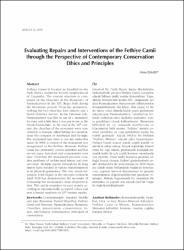Evaluating Repairs and Interventions of the Fethiye Camii through the Perspective of Contemporary Conservation Ethics and Principles
Künye
ESMER, Mine. "Evaluating Repairs and Interventions of the Fethiye Camii through the Perspective of Contemporary Conservation Ethics and Principles". Adalya, 22 (2019): 401-427.Özet
Fethiye Camii is located in Istanbul in the
Fatih district amidst the historic neighborhood
of Çarşamba. The current structure is comprised
of the churches of the Monastery of
Pammakaristos in the XIV. Regio built during
the Byzantine period. From the monastery,
nothing but two churches, four cisterns and a
burial chamber survive. In the Ottoman rule,
Pammakaristos was first in use as a monastery
for nuns and a little later it was put in use as the
Greek Patriarchate. At the end of the 16th century,
the churches of the monastery were converted
to a mosque called Fethiye to commemorate
the conquest of Azerbaijan and Georgia.
The monument has come to our day under this
name. In 1963, a section of the monument was
inaugurated as the Fethiye Museum. Fethiye
Camii has possessed various identities and has
served many functions and communities over
time. Currently the monument presents complex
problems of architectural history and conservation.
Multiple repairs throughout its long
history have resulted in various transformations
in its physical appearance. The very recent restoration
work begun in the museum section in
April 2018 has demonstrated the necessity of
evaluating the monument’s state of preservation.
This article examines its past repairs according
to internationally accepted values and
puts a special emphasis on 20th century repairs. İstanbul İli, Fatih İlçesi, Katip Musluhittin
Mahallesi’nde yer alan Fethiye Camii, Çarşamba
olarak bilinen tarihi semtte konumlanır. Yapı,
Bizans Dönemi’nde kentin XIV. bölgesinde yer
alan Pammakaristos Manastırı’nın kiliselerinden
dönüştürülmüştür. İki kilise, dört sarnıç ve bir
de mezar odası dışında hiçbir yapısı günümüze
ulaşamayan Pammakaristos, İstanbul’un fethinin
ardından önce kadınlar manastırı, sonra
patrikhane olarak kullanılmıştır. Manastırın
kiliseleri 16. yy. sonunda Azerbaycan ve
Gürcistan’ın fethi anısına “Fethiye” ismiyle camiye
çevrilmiş ve yapı günümüze kadar bu
isimle gelmiştir. Ancak 1963’te bir bölümü
“Fethiye Müzesi” olarak işlev kazanmıştır.
Fethiye Camii zaman içinde çeşitli kimlik ve
işlevlere sahip olmuş, birçok topluluğa hizmet
etmiş bir yapı olarak, günümüzde karmaşık mimarlık
tarihi ile çok çeşitli koruma sorunlarıyla
yüz yüzedir. Uzun tarihi boyunca geçirmiş olduğu
birçok onarım, fiziksel görünümünde çeşitli
dönüşümler ile sonuçlanmış ve 2018 Nisan
ayı içinde müze bölümünde başlayan restorasyon,
yapının mevcut durumunun ve geçmiş
onarımlarının değerlendirilmesini gündeme taşımıştır.
Makale kapsamında bu onarımlar ele
alınmakta ve yapının son yüzyılı özel bir vurgu
ile değerlendirilmektedir.



















